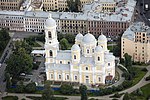Nevsky Institute of Language and Culture
The Nevsky Institute of Language and Culture is an educational institution in St. Petersburg, Russia. It is located in the Petrogradskaya District, within short walking distance from Krestovsky Island. Founded in April 1996, it offers degree programs in Linguistics and Linguistic Arts, Public Relations, Finance, Management, Accounting, Russian Studies, and European Studies. The Nevsky Institute was founded to provide Russian language study programs for foreign students, but today hosts students from inside Russia, Belarus, the Ukraine, Estonia, Moldova, and Azerbaijan as well as from the US, Great Britain, France and other countries, in a variety of academic programs. It is active in promoting exchange programs, including those with Spain, Greece, Slovenia, the UK, and the USA.
Excerpt from the Wikipedia article Nevsky Institute of Language and Culture (License: CC BY-SA 3.0, Authors).Nevsky Institute of Language and Culture
Bolshaya Raznochinnaya Street, Saint Petersburg Petrograd Side (округ Чкаловское)
Geographical coordinates (GPS) Address Nearby Places Show on map
Geographical coordinates (GPS)
| Latitude | Longitude |
|---|---|
| N 59.961944444444 ° | E 30.285833333333 ° |
Address
Bolshaya Raznochinnaya Street 27
197110 Saint Petersburg, Petrograd Side (округ Чкаловское)
Saint Petersburg, Russia
Open on Google Maps










